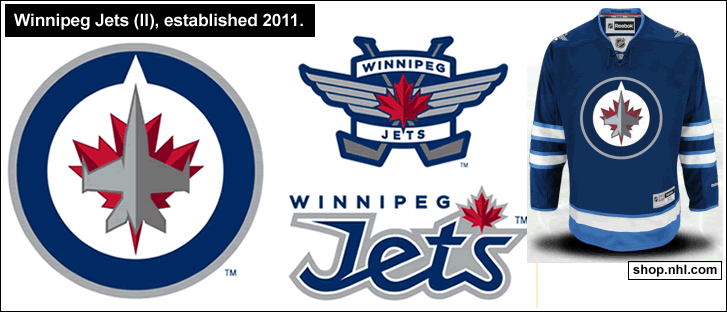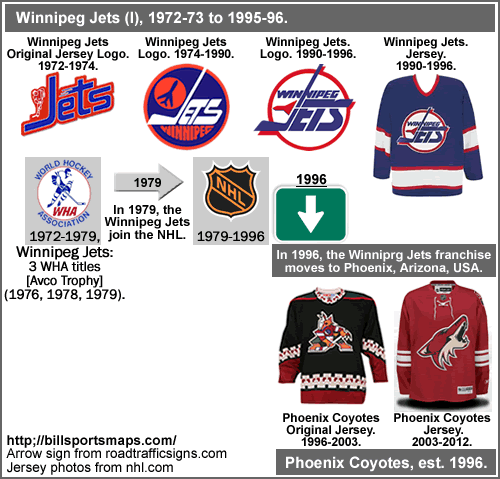
NHL, 2011-12 location map, with 2010-11 avg. attendances, and all-time titles list
…
…
NHL.com
For the fifth-straight season, the NHL will begin the season by playing a set of games in Europe…
‘NHL to play regular-season games in Europe again‘.
The 2011-2012 NHL regular season will begin on October 6. On October 7, 2 games will be played in Europe – one of which is the Anaheim Ducks versus the Buffalo Sabres in Helsinki, Finland. It is no coincidence that the Ducks are playing in Finland, because Helsinki is the birthplace of their 18-year veteran superstar Teemu Selänne, who plays Right Wing and is 41 years old, yet still was the 8th-highest scorer in the NHL last season (with 80 points). In fact, there are 4 Finnish players on Anaheim, the other three being the Ducks’ captain, and two-time-All-Star, the Center Saku Koivu; Defenseman Toni Lydman, and Goalie Iiro Tarkki. The Anaheim Ducks currently have 7 European players on their roster [all the roster lists linked to here were as of Sept.24,2011]. The Buffalo Sabres also currently have 7 European players on their roster, including Finnish LW Vinne Leino.
Also on October 7, the Los Angeles Kings will play the New York Rangers in Stockholm, Sweden. On the LA Kings’ current roster is 1 European playerr. The New York Rangers boast 8 European players on their current roster, including 3 Swedes, most notably their starting Goalie Henrik Lundqvist, as well as LW Carl Hagelin and RW Andreas Thuresson.
The following day (October 8) Stockholm, Sweden will host another regular-season game, with the Ducks vs. the Rangers; while the Sabres and the Kings will play in Berlin, Germany [this will the first-ever regular-season-NHL-game in Germany]. Buffalo has 2 German players on their current roster – D Christian Ehrhoff (ex-Vancouver Canuck), and assistant-captain and 8-season-Sabres’-veteran, the Left Winger Jochen Hecht.
Granted, team rosters are preseason-bloated and have not been pared down, but I think you get the idea. There are an awful lot of European players playing in the National Hockey League these days. And that brings us to my segue… the North American teams that were the trailblazers in utilizing European-born and European-raised talent. Sure, the New York Rangers had the first European-born-and-raised NHL player, Swedish 1964 Olympic Silver Medalist Ulf Sterner, who played 4 games for the New York Rangers in 1964-1965. But the first two major-league hockey teams in North America who played European players on a regular basis were the NHL’s Toronto Maple Leafs, and the Winnipeg Jets of the World Hockey Association. In 1973-1974, with the Swedes Borje Salming (D), and Inge Hammarström (LW), the Maple Leafs blazed the trail {here is the Hockey Hall of Fame site’s page on Borje Salming; here is an article on Borje Salming’s impact on the game in North America from Greatest Hockey Legends.com}. The following season, 1974-1975, the Winnipeg Jets signed three other Swedes, two of whom would go on to have a huge impact on the offensive style of ice hockey in North America. Those two players were Anders Hedberg and Ulf Nilsson, who, when teamed with legendary Hall of Famer Bobby Hull, formed the “Hot Line’” [Note: the third Swedish-born player who also played on the Jets back then was Defenseman Lars-Erik Sjöberg (1974-80 on Winnipeg), and Sjöberg usually played on the same shift with the Hull/Hedbergh/Nilsson line].
The two Swedes on Toronto, and Borje Salming in particular, showed that Europeans could hack it in major-league North American hockey. But the two Swedes who began playing for Winnipeg a year later would go on to prove that Europeans could win titles in North America. The trio of Nilsson (C), Hull (LW), and Hedberg (RW) played a swift, inter-weaving style of ice hockey that threw away the notion that wingers must stay in their channels. With their puck-handling skills and speed, they were able to control the flow of the game. On counter-attacks, when they switched positions as the need arose, they were swift and deadly.
From Rebel League - The Short and Unruly Life of the World Hockey Association, by Ed Willes (McLellan & Stewart, Toronto, 2004) -
{excerpt…”You could argue whether the Hull-Hedberg-Nilsson line – the Hot Line – was the best line in the game’s history, but they were inarguably the most influential. They played together for just four years, but when they were done practically every NHL team was trying to capture the magical combination of speed, skill, and creativity the line possessed. Glen Sather built his Edmonton Oilers dynasty on the Jets model. The modern transition game was pioneered by Hull and his colleagues, as was the practice of interchanging forward roles on the rush. The numbers they accumulated in their four seasons together are staggering, but they played in a league without a television contract, which means most of their legacy is anecdotal and almost mythic. In the end it only seems to add to their aura. And if the NHL never saw the best of Hedberg and Nilsson, in much the same way the NBA never saw the best of Julius Erving, it makes their four years in Winnipeg that much more memorable.
“They revolutionized the game,” says André Lacroix, the seven-year WHA veteran. “They said, Just because you play left wing doesn’t mean you have to go up and down your wing like a robot. You can use the whole ice. It was exciting”.
“…end of excerpt}
Hull, Hedberg, and Nilsson skated circles around the opposition and revolutionized the game in North America, and led Winnipeg to the first 2 of the team’s 3 WHA titles. Here’s a few numbers …in 1974-75, in their first season together, Ulf Nilsson had an astounding 94 assists (for 120 points). In 1977-78, en route to the second of Winnipeg’s 3 WHA titles, Anders Hedberg scored 76 goals in an 81-game season (and became the first-ever to score 50 goals in 50 games), and between the three of them the Hot Line amassed 365 points that season. This sort of offensive domination kick-started a scramble amongst other teams to get some European players of their own. The other WHA teams, and, more importantly, other NHL teams, soon began to dip into the vast European talent pool, to the point where, some 37 years later, roughly 25 to 30 percent of NHL players are European.
From en.wikipedia.org, ‘List of NHL statistical leaders by country‘.
…
Lack-of-new-content disclaimer…This map, which you can see by clicking on the image at the top of this post, and which I originally posted around 3 years ago {here} is basically an excuse to show off the new Winnipeg Jets (II), whose franchise moved from Atlanta, Georgia, USA to Winnipeg, Manitoba, Canada in June 2011, returning NHL hockey to Manitoba and the Canadian prairies after a 15-year absence. Thank you Gods of Hockey, for relocating a team, for once, in the proper direction. When a new NHL team comes to the Sunbelt, the collective response there is “Meh”. When a new NHL team comes to a Canadian city, the collective response there is to sell out the entire allotment of season tickets in a matter of minutes. From The Winnipeg Free Press, from June 4, 2011, by Ed Tait “Season ticket wait list capped at 8,000 following 17-minute sellout‘.
Thanks to the Canadians who got this team out of the Deep South and into the frozen North, where major league hockey teams belong. You’re next, Phoenix.

Photo credit – shop.nhl.com
‘Winnipeg Jets‘ at en.wikipedia.org.
Jets.nhl.com
Winnipeg Jets (I), 1972-1973 to 1995-1996.
7 seasons in WHA, 3 Avco Cup titles. 17 seasons in NHL.

…

_
Photo of Stanley Cup from Photobucket.com.
Photo credits (pucks) – ClassicAuctions.net (1930s) . ClassicAuctions.net (ca. late 1950s/early 1960s) . ClassicAuctions.net (“Original Six teams [on reverse of puck]). ClassicAuctions.net , here (ca. 1960s) . GasolinAlleyAntiques.com , here (ca. 1970s) . GasolineAlleyAntiques.com (1974-1983) .PittsburghHockey.net [75th] . GasolineAlley.com (ca. 1995-2008) Collectible-Supplies.com (2011 Stanley Cup Finlas puck).Amazon.com [Boston Bruins, who were 2010-11 NHL champions] .
Thanks to the contributors to the pages at en.wikipedia.org, ‘National Hockey League‘.
Thanks to ESPN for 2010-11 NHL attendances, here.
Thanks to RoadTraficSigns.com, for the arrow-sign.
Thanks to Ed Willes, for his book on the WHA…‘Rebel League, the short and unruly life of the World Hockey Association’, published by McLelland & Stewart, Toronto, 2004 {at Amazon, here}.

